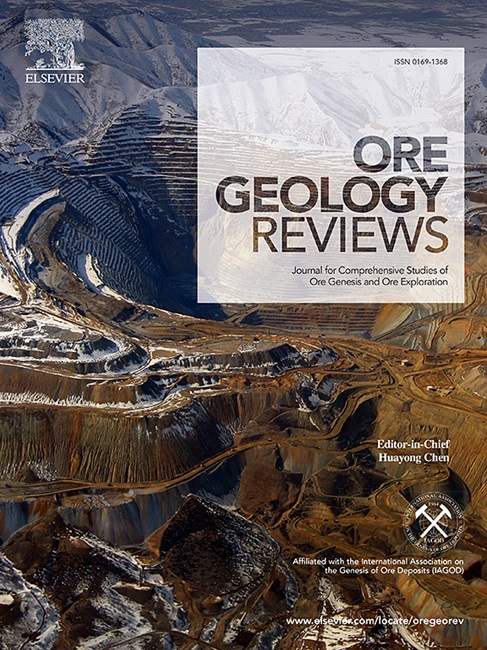Comparison of the genesis of typical antimony deposits in the Xiangzhong Antimony Ore Belt, South China
IF 3.6
2区 地球科学
Q1 GEOLOGY
引用次数: 0
Abstract
The Xiangzhong Antimony Ore Belt (XAOB), located in the central part of South China, is the most concentrated area of antimony mineralization in the world. However, the genesis of the deposits is still widely disputed. To investigate the ore-forming mechanisms and compare the genetic relationships among different antimony deposits in XAOB, we analyzed the trace element compositions of hydrothermal quartz in six typical deposits (Xikuangshan Sb, Banxi Sb, Woxi Sb-Au-W, Zhazixi Sb-W, Longkou Sb, and Longshan Au-Sb deposits) by fsLA-ICP-MS. The data show that Al, Sb, Ge, Li, Na, and K are the most enriched trace elements in quartz, and the main possible replacement mechanisms in these deposits are (Al3+, Sb3+) + (Li+, Na+, K+, H+) ↔ Si4+ and Al3+ + Ge4+ + (Li+, Na+, K+, H+) ↔ Si4+. The significant variations in trace element compositions of quartz from the six deposits reveal differences in their ore-forming mechanisms. The Xikuangshan deposit stands out with high Al, Rb, and Sr contents and a limited variation in Al, suggesting that acidic fluids may have facilitated a water–rock reaction. In contrast, quartz from the Woxi deposit shows low Al, Rb, and Sr contents with variations in Ti and Ge contents, indicating fluid boiling may have been responsible for Sb mineralization. Quartz from the Banxi, Zhazixi, Longkou, and Longshan deposits display low, variable Al and variable Ti and Ge contents, suggesting the Sb mineralization was caused by fluid mixing. The magmatic-hydrothermal system likely contributed to Sb mineralization in all deposits except the Xikuangshan deposit. In the Longkou and Longshan deposits, higher B and Ga contents in quartz suggest that a closer relationship with magmatic-hydrothermal system, with Indosinian granite providing both heat and fluids. The XAOB comprises distinct Sb metallogenic systems, which are differentiated by quartz characteristics: (1) the Xikuangshan mineralization system, primarily controlled by water–rock reactions and unrelated to the magmatic-hydrothermal system; (2) the Banxi-Woxi-Zhazixi mineralization system, where the magmatic-hydrothermal system contributed heat; and (3) the Longkou-Longshan mineralization system, granite provided both heat and fluids. This study refines existing metallogenic models for the XAOB and provides valuable insights for future exploration and prospecting.

华南湘中锑矿带典型锑矿床成因比较
湘中锑矿带位于华南中部,是世界上锑矿化最集中的地区。然而,这些矿床的成因仍存在广泛争议。为探讨XAOB不同锑矿床的成矿机制,比较其成因关系,采用fsLA-ICP-MS分析了6个典型矿床(锡矿山Sb、板溪Sb、窝溪Sb- au - w、寨子溪Sb- w、龙口Sb和龙山Au-Sb)的热液石英微量元素组成。数据表明,Al、Sb、Ge、Li、Na和K是石英中最富集的微量元素,这些矿床中可能的主要替代机制是(Al3+、Sb3+) + (Li+、Na+、K+、H+)↔Si4+和Al3+ + Ge4+ + (Li+、Na+、K+、H+)↔Si4+。6个矿床石英微量元素组成的显著差异揭示了其成矿机制的差异。锡矿山矿床Al、Rb、Sr含量高,Al含量变化有限,表明酸性流体可能促进了水岩反应。Woxi矿床石英Al、Rb、Sr含量较低,Ti、Ge含量变化较大,表明流体沸腾可能导致Sb矿化。板溪、寨子溪、龙口和龙山矿床的石英显示出低的可变Al和可变Ti、Ge含量,表明Sb矿化是由流体混合引起的。岩浆-热液系统对除锡矿山矿床外的其他矿床均有成矿作用。在龙口和龙山矿床中,石英中较高的B和Ga含量表明其与岩浆-热液系统的关系更密切,印支花岗岩既提供热量又提供流体。XAOB具有明显的Sb成矿系统,其石英特征可区分为:(1)锡矿山成矿系统主要受水-岩反应控制,与岩浆-热液系统无关;(2)岩浆-热液系统为板溪-沃溪-扎子溪成矿系统提供热量;(3)龙口—龙山成矿体系,花岗岩既提供热量又提供流体。该研究完善了XAOB现有的成矿模式,为今后的找矿工作提供了有价值的参考。
本文章由计算机程序翻译,如有差异,请以英文原文为准。
求助全文
约1分钟内获得全文
求助全文
来源期刊

Ore Geology Reviews
地学-地质学
CiteScore
6.50
自引率
27.30%
发文量
546
审稿时长
22.9 weeks
期刊介绍:
Ore Geology Reviews aims to familiarize all earth scientists with recent advances in a number of interconnected disciplines related to the study of, and search for, ore deposits. The reviews range from brief to longer contributions, but the journal preferentially publishes manuscripts that fill the niche between the commonly shorter journal articles and the comprehensive book coverages, and thus has a special appeal to many authors and readers.
 求助内容:
求助内容: 应助结果提醒方式:
应助结果提醒方式:


